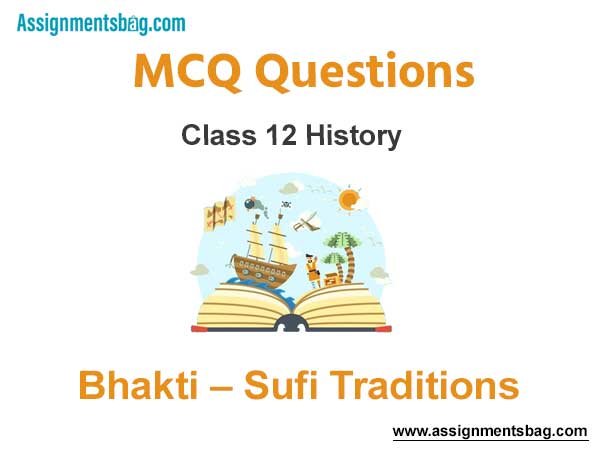Please refer to MCQ Questions Chapter 6 Bhakti – Sufi Traditions Class 12 History with answers provided below. These multiple-choice questions have been developed based on the latest NCERT book for class 12 History issued for the current academic year. We have provided MCQ Questions for Class 12 History for all chapters on our website. Students should learn the objective based questions for Chapter 6 Bhakti – Sufi Traditions in Class 12 History provided below to get more marks in exams.
Chapter 6 Bhakti – Sufi Traditions MCQ Questions
Please refer to the following Chapter 6 Bhakti – Sufi Traditions MCQ Questions Class 12 History with solutions for all important topics in the chapter.
MCQ Questions Answers for Chapter 6 Bhakti – Sufi Traditions Class 12 History
Question. Identify the Bhakti tradition which favoured widow remarriage.
(A) Alvars
(B) Nayanars
(C) Lingayats
(D) Siddhas
Answer
C
Question. Which of these statements is correct?
(A) Early Bhakti movements were led by Alvars, Nayanars.
(B) The Alvars were devotees of Shakti.
(C) The Nayanars were devotees of Vishnu.
(D) Sufis were not a part of the Islamic world.
Answer
A
Question. During which period was there a striking visibility of wide range of Gods and Goddesses in sculpture and texts?
(A) 6th to 18th century
(B) 18th to 21st century
(C) 8th to 18th century
(D) 7th to 16th century
Answer
A
Question. Where did the early Bhakti movements originate from?
(A) South India
(B) North India
(C) The West
(D) Both (A) and (C)
Answer
C
Question. Identify which of the following aspects is NOT common to both Bhakti movement and Sufi movement?
(A) Personal love for God
(B) Worship of idols
(C) Mysticism
(D) Visit to holy shrines
Answer
B
ASSERTION AND REASON BASED MCQs :
Questions. Assertion (A): When the Shaikh died, his tombshrine (dargah, a Persian term meaning court) became the centre of devotion for his followers.
Reason (R): People believed that the dead saint was united with God and is closer to Him after death as compared to when he was living.
(A) Both A and R are true and R is the correct explanation of A.
(B) Both A and R are true but R is NOT the correct explanation of A.
(C) A is true but R is false.
(D) A is false and R is true.
Answer
A
Question. Assertion (A): During the Islamic rule in India, Namdeva the Bhakti Saint venerated in Sikhism and as well as Hindu warrior-ascetic traditions such as the Dadupanthis and the Niranjani sampraday.
Reason (R): Namdev was influenced by Vaishnavism and became widely known in India for his devotional songs set to music (bhajankirtans).
(A) Both A and R are true and R is the correct explanation of A.
(B) Both A and R are true but R is NOT the correct explanation of A.
(C) A is true but R is false.
(D) A is false and R is true.
Answer
B
Question. Assertion (A): Of the groups of sufis who migrated to India in the late twelfth century, the Chishtis were the most influential.
Reason (R): They adapted successfully to the local environment and adopted several features of Indian devotional traditions.
(A) Both A and R are true and R is the correct explanation of A.
(B) Both A and R are true but R is NOT the correct explanation of A.
(C) A is true but R is false.
(D) A is false and R is true.
Answer
A
CASE-BASED MCQs :
Question. Study the picture and then read the following excerpt carefully and answer the following questions:

One of the most striking examples of this process is evident at Puri, Orissa, where the principle deity was identified, by the 12th century, as Jagannath (literally, the lord of the world), a form of Vishnu.
Question. This picture is one of the most striking example of:
(A) Nayanar Bhakti Movement
(B) Lingayat Sect
(C) Integration of cults
(D) Alvar Bhakti Movement
Answer
C
Question. Lord Jagannath is associated with:
(A) Brahma
(B) Vishnu
(C) Shiva
(D) All of the above
Answer
B
Question. Assertion (A): Jagannath was literally the Lord of the world.
Reason (R): Lord Vishnu was worshipped in various avatars.
(A) Both A and R are correct and R is the correct explanation of A.
(B) Both A and R are correct but R is not the correct explanation of A.
(C) A is incorrect but R is correct.
(D) R is incorrect but A is correct.
Answer
B
Question. Consider the following statements :
(i) Lord Jagannath has been depicted here with his sister Subhadra and brother Balaram
(ii) Lord Jagannath has been depicted here with his wife Sita and brother Lakshman.
Choose the correct option:
(A) Only (i) is correct
(B) Both (i) and (ii) are correct.
(C) Only (ii) is correct.
(D) Neither (i) nor (ii) is correct
Answer
A


